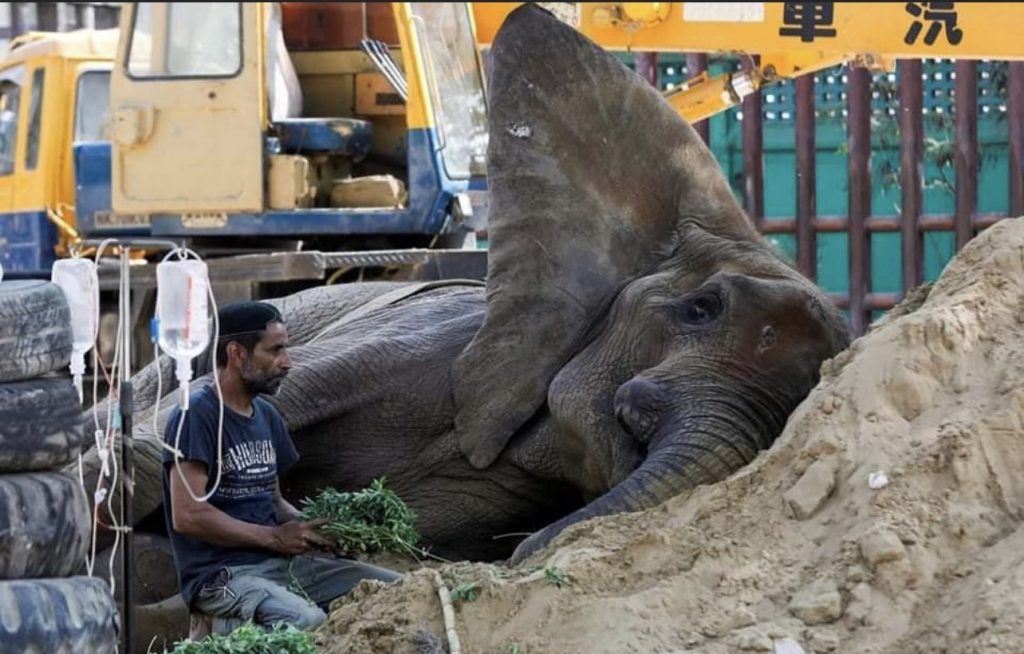One hopes that Noor Jehan’s life, suffering and death in captivity were not in vain. Her plight drew the attention of the entire world towards the suffering that captive animals endure in zoos around the world
Try as I might, I cannot get the images of Noor Jehan, the 17-year-old African elephant, dragging her paralysed hind legs and walking painfully while being hit and prodded by insensitive mahouts who pulled at her ears impatiently and beat her around the legs in an attempt to make her walk faster.
I cannot get the image of Noor Jehan standing with her head resting against the drab wall of a dry, poorly-maintained, cramped enclosure. The abject despair, sadness and loneliness in her countenance were enough to tell a horrific tale of years of abuse, even if she could not.
You don’t need to have a doctorate in animal psychology to know that Noor Jehan was a broken animal. Broken in spirit, body and mind! It takes a lot of abject cruelty, beatings, indiscriminate use of the dreaded bullhook, physical, emotional and mental abuse to turn a giant, wild elephant into a broken, shriveled, rag. When I first saw her pictures I thought it was an old elephant as they can live till the age of 70. I was appalled and shocked to learn she was just 17! A teenager, in the prime of her youth! I cannot even begin to imagine the amount of abuse, neglect, hunger and pain that the poor 17-year-old elephant had to endure in her short life on this earth, because that’s what it would take to make a 17-year-old look 70.
Noor Jehan’s story of tribulations began when she saw her mother being butchered in front of her as a young calf in Tanzania before she was hauled off along with three other baby elephants, Madhubala, Sonia and Malika to Pakistan in 2009, to begin life imprisonment in the worst prison on this earth. While Sonia and Malika were sent to Karachi Safari Park, Noor Jehan and Madhubala were sent to Karachi Zoo.
Treated even at a young age more as a commodity to bring in money, rather than as a living being which felt pain and fear, for both the elephants Karachi Zoo was hell on earth, where they were imprisoned even though they had committed no crime. In the end, years of deprivation and suffering took its toll on Noor Jehan. The elephant, which had been ailing since November 2022, and had been suffering from fever for many days, died. In the end, Noor Jehan, succumbed to the constant abuse she was subjected to. Even though she underwent critical medical treatment under the supervision of international veterinarians, she could not survive, maybe because she did not have the will to live her miserable life anymore.
Foreign experts who had been called in by Karachi zoo because they could not figure out what was wrong with her for months, detected a large haematoma (A pool of mostly clotted blood that forms in an organ, tissue, or body cavity) in her abdomen and found the perineal (the thin layer of skin between the genitals and anus) membrane ruptured. (I wonder how that happened?) This condition made walking and movement very painful and also was the cause behind her unusual posture. In the end, she suffered a fall while trying to get into her pool and was unable to get up.
The international animal welfare organisation Four Paws’ team that arrived at Karachi Zoo following an SOS from zoo officials was unable to save Noor Jehan, who went to a better place at 11:15 am on April 22. Sadly, they had been trying to get her well enough so that Noor Jehan and her companion Madhubala could be relocated to a species-appropriate place that fulfils international standards. But that was not to be. However, now, that Noor Jehan is no more, one can only hope that her life, suffering and death were not in vain. Her plight drew the attention of the entire world towards the suffering that captive wild animals endure in zoos around the world and in Pakistan in particular. I say Pakistan in particular because their zoos are often accused of being unmindful of animal welfare and having poor facilities. For instance, two lions died of asphyxiation in Pakistan after handlers tried to get them out of their den using smoke!
Thankfully, the director of the Karachi Zoo was removed over complaints of negligence and a new, hopefully more sympathetic one was brought in a few weeks before Noor Jehan’s death. Also, a court in 2020 ordered the closure of the Islamabad Zoo, where the “loneliest” elephant Kaavan was kept before he was rehabilitated to a sanctuary in Cambodia after years of international pressure and campaigns, due to his deplorable state.
One hopes that the Karachi Zoo will be shut down soon and Madhubala and the two remaining elephants Malika and Sonia at the Karachi Safari Park and all the other animals who are in an equally deplorable, abused and starved state in Karachi Zoo will be rescued from this house of horrors. One hopes they will be rehabilitated in a sanctuary or sent to more species-appropriate facilities outside Pakistan.

After reading about the plight of animals in zoos I am convinced that it’s time that zoos were shut down globally. It may seem a bit of a drastic statement to make, but there was a time when performances by animals were considered a vital part of circuses worldwide. However, slowly and surely, thanks to the awareness created by animal rights activists and journalists, people became aware of the horrific lives full of beatings and starvation these wild beasts were being forced to live for our one evening of entertainment. Today, by and large, most nations, including India, have banned the use of wildlife in circuses. And our circuses are none the worse for it. In fact, one of the most renowned and premium circuses in the world, Cirque du Soleil, does not use any animals at all.
Now, it’s time for zoos to be shut down globally! Why should animals be snatched from their families and natural habitat and forced into life imprisonment? Why should an animal suffer loneliness, loss of freedom, beatings, and starvation just so that humans can entertain themselves?
But this call for the release and rehabilitation of captive zoo animals should not be restricted to Pakistan alone. There are a number of zoos around the world where animals are kept in captivity in appalling conditions for our viewing pleasure. They are snatched from their families in the wild and incarcerated for the rest of their lives, forced to live in isolation, and abused by ill-trained caretakers. Take for example the case of the elephant Lucy in Edmonton Valley Zoo. Brought from Sri Lanka after being orphaned, Lucy has been at the Edmonton Valley Zoo for 46 years and turns 48 this year. Lucy suffers from a number of zoo-induced ailments which will shorten her life expectancy as zoo elephants hardly ever live out their full days. She has no other elephant companions, which is cruel because elephants are highly complex social creatures like humans and cannot live alone.
The harsh Edmonton climate is detrimental to her health and painful for her arthritis and foot disease. This is made worse by the fact that Lucy lives in a tiny concrete cell and is only allowed outdoors for short controlled walks, weather permitting which means many days she never gets out at all. She spends her day in her cramped, wired, concrete enclosure just moving forward a few inches, touching her forehead to the wire, and then moving back a few inches. This is all she does the whole day, which is indicative of high levels of mental and emotional distress. The sad part is that while two sets of animal doctors and experts have ruled that Lucy can be moved to a sanctuary where she can live out the rest of her days in a happy and beautiful environment, the authorities of the zoo are not willing to let her go. Maybe it’s ego, or just the loss of revenue that scares them. Whatever their concerns are, one thing is clear: Lucy has to go to a sanctuary if she is to live any longer.
Then there is Shankar, the elephant from Zimbabwe who has been in the Delhi Zoo for the last 24 years. A friendly country Zimbabwe gifted Shankar to India in 1998 when he was just 26 months old. However, Shankar has been alone since the death of his partner, Bombai, in 2005.
Nikita Dhawan, the founder of Youth for Animals, had filed a petition in Delhi High Court seeking the release and rehabilitation of Shankar to a suitable wildlife sanctuary. In her petition to the Delhi High Court, she had claimed that the elephant was a victim of cruelty and viciousness at the hands of the handlers and the call for sending Shankar back to his home grew exponentially. However, sadly after a court ruled that Shankar cannot be sent home, the Delhi Zoo is exploring the option of finding a mate for Shankar from South Africa. Till that happens, Shankar will continue to suffer a lonely life in an enclosure in the middle of a bustling city, instead of roaming free in his natural habitat.
Even though Noor Jehan’s death has thrown the spotlight on the plight of elephants in zoos around the world, the condition of other animals incarcerated in dirty, cramped spaces, sometimes in groups or sometimes in isolation, is the same.
So, there should be a conscious, concerted decision-making process and a force for change around the world and zoos should be shut. The animals should be re-wilded, rehabilitated and released in sanctuaries. It will take a lot of political will and effort to do so but at least we will not be guilty of being responsible for the misery of countless species just for our entertainment. And what a perverse and macabre source of entertainment it is, because, other than that, zoos serve no other purpose. They certainly don’t serve an educative purpose, unless you want to teach your children that only human lives matter and the sufferings of other species are subservient to our desire for base entertainment. If you want to teach your child about an elephant, or lion, deer, rhino, or monkey, show them the beautiful, educative, and comprehensive documentaries made by Animal Planet, National Geographic, and Discovery to name a few. Not only will they be entertained, but they will also grow up into well-informed, sensitive individuals with a healthy respect for the voiceless creatures they have to share this beautiful planet with. Or, if you can afford it, take them to a wildlife sanctuary to see the animals in their natural habitat.
In the end, we will be bringing up individuals who will have empathy for animals and not individuals who think nothing of killing one and grow up with the misconception that this planet and all its resources are meant for humans only and everyone else is an intruder, to be shot, trapped or beaten to death. This man-animal conflict that we are increasingly witnessing as habitats shrink at a rapid pace globally, will be reduced to an extent if we educate our children about the lives of animals, their rights, and their importance in the scheme of things. Visiting a zoo is not the right way to educate your children about animals. It’s time to shut the houses of horror zoos, globally.












